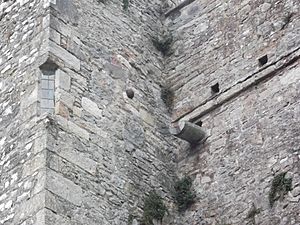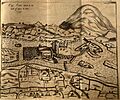Siege of Cahir Castle facts for kids
Quick facts for kids Siege of Cahir Castle |
|||||||
|---|---|---|---|---|---|---|---|
| Part of the Nine Years' War | |||||||
 Cahir Castle |
|||||||
|
|||||||
| Belligerents | |||||||
| Commanders and leaders | |||||||
| Earl of Essex | James Galdie | ||||||
| Strength | |||||||
| 4,000–5,000 | Several hundred in garrison 5,000 more in the vicinity |
||||||
| Casualties and losses | |||||||
| low | 80–100 killed | ||||||
The Siege of Cahir Castle happened in 1599 in Munster, southern Ireland. It was a big event during the Nine Years' War (1595-1603). The Earl of Essex, an English commander, led his army to capture Cahir Castle. Even though the castle was thought to be super strong, Essex took it in just a few days. He used powerful cannons to break through its defenses. However, Queen Elizabeth I wasn't very impressed. She said the castle's defenders were just a "rabble of rogues."
Contents
Essex's Campaign in Ireland
In April 1599, the Earl of Essex arrived in Dublin, Ireland. He brought the largest army ever seen in Ireland at that time. There were 16,000 foot soldiers and 1,300 horsemen. Essex decided not to fight the main rebel leader, Hugh O'Neill, in the north. Instead, he focused on the southern part of the country.
This southern area was important because England worried that Spain might send help to the Irish rebels. England had faced the Spanish Armada before and didn't want another attack. Essex's journey through Munster province was quite difficult. He managed to capture Derrinlaur Castle first. Then, he set his sights on the even more important Cahir Castle, which was further along the River Suir.
Cahir Castle was a very important target. Any army wanting to move west into rebel territory needed to control it. The castle was built on a rock right in the middle of the river. People thought it was impossible to capture because of its strong location. It had a large main tower protected by six sturdy smaller towers and thick outer walls.
At that time, Thomas Butler, 4th Baron Cahir, an Irish nobleman, owned the castle. His brother, James Galdie, was in charge of defending it. Before taking Derrinlaur Castle, Essex had accused Baron Cahir of helping the rebel White Knight. But as the English army got ready to march from Clonmel, Baron Cahir promised that James Galdie would surrender Cahir Castle as soon as the English arrived.
The Siege of Cahir Castle
Preparing for Battle
On May 25, Essex divided his army into three groups. The first group, called the vanguard, led the way. The main army gathered a mile outside Clonmel. Heavy cannons, a large cannon and a smaller culverin, were brought by water to the quay. Essex watched over this process.
With protection from the rearguard and horsemen, the cannons were pulled by hand. They had to be dragged 10 miles to Cahir because there weren't enough horses. The weather was bad, and the bridges groaned under the weight of the guns. Essex rode ahead with his army. They stopped a mile from the castle and waited for the artillery to catch up.
Lord Cahir was sent ahead to ask his brother, James Galdie, to surrender the castle. He was told to let an English army group enter. But James Galdie's men responded with threats and insults. Essex then accused Lord Cahir of breaking his promise. Lord Cahir suggested another talk, but Essex was determined to capture the castle. So, Lord Cahir and his wife were placed under guard.
Planning the Attack
A meeting was held with important leaders, including the Earl of Ormond. The army was stuck in one place, and their supplies were running low. The bad weather and flooded river plain also meant more soldiers could get sick. There was also a rumor that 5,000 rebel fighters were gathering nearby. Essex ordered more ammunition from Waterford and food from the local town and countryside.
In the evening, Essex looked at the castle with George Bingham. Bingham was an expert who had successfully attacked another island castle in 1594. They decided to approach the castle from the east side. They would use old ditches and a wall for cover. A trench would be dug close to the riverbank, about 50 paces from the castle. This trench would be a good spot to set up the cannon.
Engineers worked to build the defenses, protected by musketeers (soldiers with muskets) and caliver men. They used gabions, which are wicker baskets filled with earth, to shield themselves from enemy fire. The culverin, the smaller cannon, was placed further back. This gave it a wider view of the castle's sides.
The Cannon Attack Begins
On Saturday, May 26, the vanguard and main army moved closer to the castle. They set up camp on the east bank. Essex could have surrounded the castle by sending men to the west bank. But he chose not to, fearing his men wouldn't be able to get back quickly if attacked. In the afternoon, people were still moving freely in and out of the castle. Essex ordered 300 soldiers to take the orchard garden on the south side. This garden had thorny bushes around its edges. The soldiers quickly took the garden, losing only a few men, even though they were very exposed crossing the river.
Later that day, the rearguard arrived with the cannons. After a night of preparation, the guns were ready on the east bank by Sunday, May 27. They opened fire. The large cannon was very close to the castle, but its carriage broke after only the second shot. It took a day and a half to fix it. Then, a cannonball got stuck in the culverin, but this was quickly cleared. Fifty shots were fired, and the castle's defenders stopped firing back. They couldn't stay in any tower or fight from that side of the castle. During the cannon attack, Lord Cahir and his wife were said to have cried.
From the west bank, the White Knight sent a few dozen kerne (lightly armed Irish soldiers) to help the castle. They also took away those who couldn't fight. Essex sent Christopher St Lawrence to an island on the north-east. This island had two bridges connecting the castle to the west bank. The bridges were broken, and supplies were brought to the island by moving boats overland past the castle and putting them in the river upstream.
In the evening, the large cannon was put back on its carriage. The culverin was moved a little closer. On May 28, the cannon attack continued at close range. A large hole was made in the east wall of the castle. Plans were made for a full attack the next morning. Engineers made climbing ladders, scaffolds, and "sows" (movable protective screens). Petards, which were wooden cases of gunpowder, were prepared to blow open doors or break down walls. The plan was for four groups of experienced soldiers to attack through a trench after the gunpowder exploded.
The Castle Falls
During the night, the castle's defenders tried to sneak away. But they were spotted by Charles Percy and St Lawrence, who had four companies of experienced soldiers. At least 80 defenders were killed along the river. However, James Galdie escaped with some of his men through a secret tunnel under a watermill. The English soldiers entered the castle courtyards that night without any resistance.
On the morning of May 29, Essex entered the castle. The cannons were soon placed on the deserted walls, and the holes in the walls were repaired. One hundred soldiers were left to guard the castle under the command of George Carey. Carey had suffered a face wound during the siege and later died from it. The army rested in camp until May 31. The sick and wounded soldiers were sent to Clonmel. The bridge at Golden had been repaired, allowing Essex to cross the River Suir and enter rebel territory in west Munster.
After the Siege
Essex was very proud of capturing Cahir Castle. But Queen Elizabeth I didn't think it was a big deal. She called the castle's defenders a "rabble of rogues." Soon after, Essex's campaign stopped. He made a controversial peace agreement with O'Neill and then quickly left Ireland to try and fix his relationship with Queen Elizabeth.
In the next year, 1600, 60 rebels led by James Butler recaptured the castle without a fight. Later, the castle was given back to Sir George Carew after he threatened to attack it.
Images for kids



